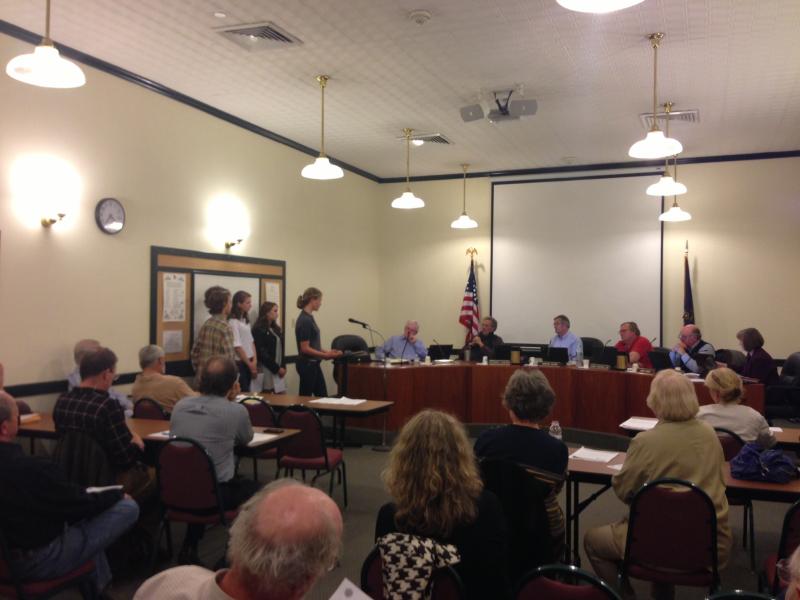Camden supports exploration of micro-hydro power project at harbor dam
 Camden Hills Regional High School students Kate Sensenig, Aidan Acosta, Max Horovitz, Kiera Haining and Abby Blakeley request support from the Camden Select Board Oct. 15 to allow for the future installation of a micro-hydro power project on the dam at the mouth of the Megunticook River.
Camden Hills Regional High School students Kate Sensenig, Aidan Acosta, Max Horovitz, Kiera Haining and Abby Blakeley request support from the Camden Select Board Oct. 15 to allow for the future installation of a micro-hydro power project on the dam at the mouth of the Megunticook River.
 The Montgomery Dam sits at the head of Camden Harbor. (Photo by Lynda Clancy)
The Montgomery Dam sits at the head of Camden Harbor. (Photo by Lynda Clancy)
 Camden’s Waste Water Plant Superintendent and Maine Department of Environmental Protection’s Dan Davis stand at the top of the Montgomery Dam during an oil spill incident that occurred last winter. (Photo by Lynda Clancy)
Camden’s Waste Water Plant Superintendent and Maine Department of Environmental Protection’s Dan Davis stand at the top of the Montgomery Dam during an oil spill incident that occurred last winter. (Photo by Lynda Clancy)
 Camden Hills Regional High School students Kate Sensenig, Aidan Acosta, Max Horovitz, Kiera Haining and Abby Blakeley request support from the Camden Select Board Oct. 15 to allow for the future installation of a micro-hydro power project on the dam at the mouth of the Megunticook River.
Camden Hills Regional High School students Kate Sensenig, Aidan Acosta, Max Horovitz, Kiera Haining and Abby Blakeley request support from the Camden Select Board Oct. 15 to allow for the future installation of a micro-hydro power project on the dam at the mouth of the Megunticook River.
 The Montgomery Dam sits at the head of Camden Harbor. (Photo by Lynda Clancy)
The Montgomery Dam sits at the head of Camden Harbor. (Photo by Lynda Clancy)
 Camden’s Waste Water Plant Superintendent and Maine Department of Environmental Protection’s Dan Davis stand at the top of the Montgomery Dam during an oil spill incident that occurred last winter. (Photo by Lynda Clancy)
Camden’s Waste Water Plant Superintendent and Maine Department of Environmental Protection’s Dan Davis stand at the top of the Montgomery Dam during an oil spill incident that occurred last winter. (Photo by Lynda Clancy)
CAMDEN — A proposal to explore installing a hydro-power turbine at the Montgomery Dam, which sits at the head of Camden Harbor where the Megunticook River spills into the ocean, received unanimous support from the Camden Select Board Tuesday evening. Following a brief discussion, the board asked the Dam Committee, comprising representatives of Camden, Hope and Lincolnville, to address its feasibility.
Camden Hills Regional High School students Kate Sensenig, Aidan Acosta, Max Horovitz, Kiera Haining and Abby Blakeley made an initial request Oct. 15 at a regularly scheduled Camden Select Board meeting to incorporate a valve and pipe as part of a pending dam rebuild project.
The students said their focus was on increasing energy efficiency and renewable energy in the school and community.
The dam is on the municipal repair list and the students said the project could coincide with the larger redesign of the Camden Public Landing. Currently, the town is developing requests for proposals for the dam rebuild.
The dam is constructed of stone and concrete, and was designed to have a consistently-leveled spillway so that the river water can flow evenly over the wall, down the rocks and into the harbor. The repairs there involve masonry work to the top of the dam, which has deteriorated in a few spots. The Montgomery Dam design is functional, as well as aesthetic, making for one of the most photographed features of the Camden landscape.
The students, members of the high school’s Windplanners group, hope to install a valve as the first step of a hydro-electric project that would, they said, have the potential to produce approximately five kilowatts of power per hour.
“The town has a rich history of using hydro-power,” said Aidan Acosta. “There have been 16 generating sites on the river with the Seabright Dam still producing power.”
Seabright currently generates approximately 300,000 kilowatt hours on an annual basis. That power is routed back to the regional electric grid, and the town shaves the retail value of that Seabright-produced energy off its monthly Central Maine Power bill through a net energy billing arrangement.
The project at the Montgomery Dam would entail installing a valve, followed by pipes, penstock, turbine, and a cable to connect to the power grid. Central Maine Power would the be recipient of the power, or the energy would be directly linked to a town facility, such as the Camden Public Library, according to the students.
They are pursuing hydropower at the head of the harbor because, they said:
* They have estimated there is an “excellent head of pressure anticipated because of the vertical difference between a valve that would be installed at Montgomery Dam to just below the level of the Public Landing,” Acosta said. The water falls over a drop of nine to 15 feet.
* The Camden Hills Windplanners would claim the carbon savings to help move the school campus to being carbon neutral.
* The high-profile and easy-access location at the head of the harbor would be a desirable site for education and tourism.
* The project could be a “great school-town partnership,” said Horovitz.
“Design and installation would be in phases, each with approval sought at the appropriate level, as guided by the Select Board,” said Haining. First, the valve/pipe would be installed in new concrete at the dam when it is being reconstructed, she said. “The remainder of installation would happen at the time of reconstruction work at the town landing.”
The cost of installing a valve should be minimal, the students told the board. They anticipate that the waste water treatment plant already has a valve.
At the Oct. 15 meeting, board members agreed the Dam Committee should assess the feasibility of the hydro project with the students. Dam Committee member Rick Knowlton, who was at the meeting for another agenda item, said: “I think this is a perfect opportunity for the committee to get together and help out. We have some knowledge to pass along. The Dam Committee is a perfect place to land for the next step.”
That committee includes Lincolnville and Hope members because both towns are affected by lake water levels.
Gartley and Dorsky Engineering and Surveying, of Rockport, are currently working on plans for the reconstruction of the dam.
The Select Board said the waterfall at the harbor is important to the town’s identity.
“We’ll be getting a lot of calls if no water falls,” said Select Board member John French.
The months of August, September and October and generally drier, and during those times, it is likely the energy production would be exempted.
Knowlton said Oct. 16 that the proposed project, while small, represents “wonderful examples of alternative technology.”
The economic savings of such projects are realized through the net energy billing arrangement, as opposed to selling power on the wholesale market, he explained.
The billing arrangement is a bookkeeping function by CMP and was originally designed and approved by the state for commercial and industrial energy producers.
“It’s a great application for hydro and solar,” Knowlton said. “We sell the power to ourselves. You can offset what you otherwise need [in energy consumption].”
The power is exchanged with CMP at full retail value, he said.
The Montgomery Dam repairs are to be made in 2014. The Dam Committee will be scheduling a meeting soon.
Reach Editorial Director Lynda Clancy at lyndaclancy@penbaypilot.com; 706-6657.
Event Date
Address
United States


























